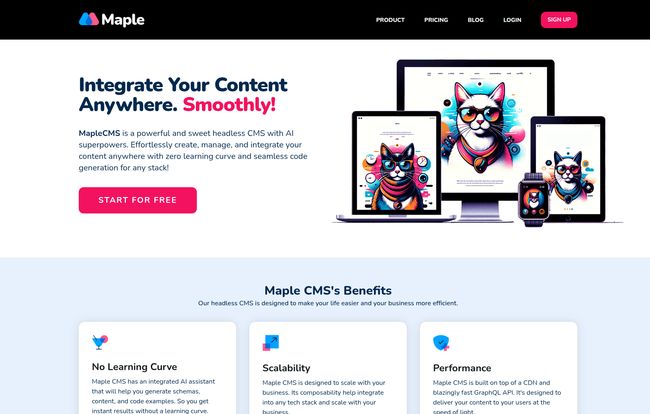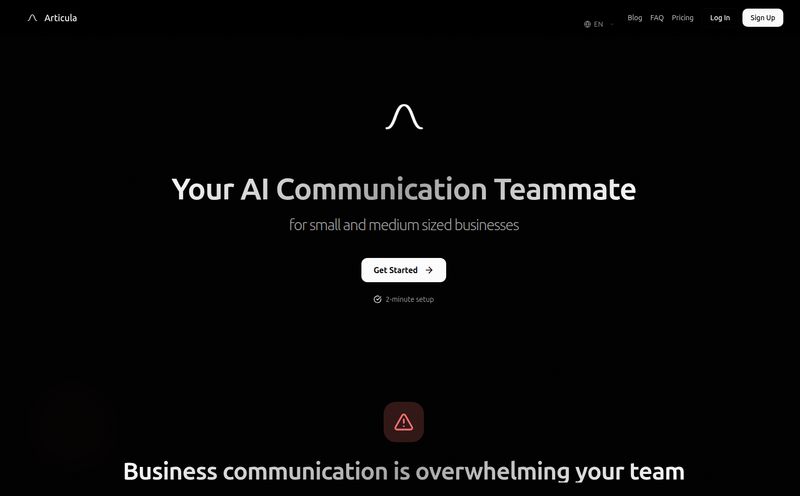If you've been in the digital marketing or web development game for more than a few years, you’ve felt the pain of a clunky, monolithic CMS. You know the one. The platform that makes a simple text change feel like performing open-heart surgery, where the backend and frontend are so tangled together they look like a forgotten pair of headphones. Every update is a prayer, and every new feature request sends a shiver down the developer's spine.
For a while now, the cool kids have been talking about a better way: the headless CMS. And I get it, the name sounds a bit… gruesome. But the idea is brilliant. It’s time to separate your content from its presentation. Think of it like this: your content is the water, and your website, mobile app, or smart fridge screen is the glass. A headless CMS just holds the water, letting you pour it into any glass you want. Simple, clean, and incredibly flexible.
But now there’s a new flavor on the market, one with a particularly sweet name: MapleCMS. It’s not just another headless CMS; it’s one with, as they say, “AI superpowers.” And honestly, my curiosity was piqued. Is this just marketing fluff, or is it a genuinely useful tool that could change how we manage content? I had to find out.
Meet MapleCMS: Is It as Sweet as It Sounds?
First impressions matter, and MapleCMS makes a good one. The website is clean, the messaging is clear, and they have a cat in a hoodie and glasses as a mascot. I mean, come on. That’s an instant win in my book.
The core promise of MapleCMS is to be a headless CMS with virtually no learning curve. That’s a bold claim. They aim to achieve this with a built-in AI assistant designed to help with everything from generating your content structure (schemas) to creating the actual content and even spitting out code snippets for integration. It’s an ambitious goal, aiming to bridge the all-too-common gap between the people who create the content and the people who have to build the things that display it.
So, you get the flexibility of a modern Jamstack-ready architecture, powered by a fast GraphQL API and a global CDN, but without the intimidating setup process that can sometimes come with these systems. It sounds like they're trying to give us the best of both worlds.

Visit Maple CMS
Who Is This For? A Breakdown for the Whole Team
MapleCMS isn’t just shouting into the void; it has specific people in mind. And from what I see, they’ve thought this through pretty well. It's not just a tool for one part of your team, but an ecosystem for everyone involved in content.
For the Devs Who Just Want to Code
Developers will probably breathe a sigh of relief here. The biggest win is the GraphQL API. No more wrestling with clunky REST endpoints or getting way more data than you need. You ask for what you want, you get what you want. The provided SDKs and code examples are a huge plus, cutting down on the time it takes to get from A to B. The AI can even help generate schemas, which is a nice touch for getting a project off the ground fast. It feels less like fighting your tools and more like your tools are actually helping you do your job.
For the Marketers and Writers
This is where the AI really starts to shine for the non-coders. The promise of a rich text editor is standard, but the AI assistant is the game-changer. Imagine being able to generate engaging social media blurbs, blog post excerpts, or product descriptions that stay consistent with your brand voice, all from within the CMS. That’s powerful stuff. It means less time spent on mundane copy-pasting and more time on high-level strategy. Plus, the collaboration features mean you can work with your team, leave comments, and manage workflows without endless email chains.
For the People in Charge
If you're a business owner or a department head, you care about oversight, efficiency, and brand consistency. MapleCMS positions itself as a central hub for all your content operations. With clear team management and content oversight features, you get a bird's-eye view of what's happening. And because the AI can be trained on your brand, it helps ensure that everything—from the website to the mobile app—feels cohesive. It’s about control, but without the micromanagement.
The Tech That Makes It Tick
Let's pop the hood for a moment. A few key pieces of technology make MapleCMS interesting from a performance and usability standpoint.
- The AI Assistant: This is the star of the show. It’s integrated at every step, from defining the structure of your content to writing it. I was skeptical, but the testimonial about it generating JavaScript code is intriguing. This isn’t just a fancy version of ChatGPT; it seems to be a context-aware tool built directly into the workflow.
- GraphQL API: I mentioned this before, but it's worth repeating. For anyone building modern web experiences, GraphQL is just a cleaner, more efficient way to fetch data. It directly impacts your site's performance and the developer's sanity.
- Built-in CDN: Your content and assets are served from a Content Delivery Network (CDN) out of the box. For the non-technical folks, this just means your images and text are stored on servers all around the world, so they load lightning-fast for your users, no matter where they are. This is a huge deal for SEO and user experience.
The All-Important Question: MapleCMS Pricing
Alright, let’s talk money. A great tool is only great if you can afford it. MapleCMS uses a pretty standard tiered pricing model, which I've laid out below. All paid plans are priced per month but billed yearly.
| Plan | Price (Billed Yearly) | Key Features |
|---|---|---|
| Free | $0 | 1 User, 1 Project, 10 Schemas, 25 Content Entries, 100MB storage |
| Starter | $39 /month | 5 Users, Unlimited Projects, Unlimited Schemas & Entries, 5GB storage |
| Business | $79 /month | 20 Users, Unlimited Projects, Unlimited Schemas & Entries, 20GB storage |
| Scale | $149 /month | 50 Users, Unlimited Projects, Unlimited Schemas & Entries, 100GB storage |
| Enterprise | Contact for Pricing | 100+ Users, Unlimited everything, 1TB+ storage, dedicated support |
The Free plan is genuinely useful for a small personal project or just to kick the tires and see if you like it. The limits are fair. Once you move to the Starter plan, things open up significantly. For a small team or agency, $39/month for 5 users and unlimited projects feels very competitive. The pricing scales reasonably from there, catering to growing businesses.
Let's Be Real: Any Sticky Spots?
No tool is perfect, and it’s my job to be a bit of a cynic. So, what are the potential downsides?
First, the reliance on AI is both a strength and a potential weakness. AI-generated content is getting scarily good, but it still needs a human touch. You can’t just blindly trust everything it produces. You’ll still need to review, edit, and fact-check. Treating the AI as a very clever assistant rather than a replacement for a human is the right mindset.
Second, the free plan, while great for testing, is quite limited. 25 content entries can be used up pretty quickly on a small blog. This is obviously by design—they want you to upgrade—but it’s something to be aware of. You’ll know pretty fast if you need to move to a paid plan.
My Honest Take After Years in the SEO Trenches
So, what’s the final verdict? I'm genuinely optimistic about MapleCMS. For years, the problem has been that the most powerful tools were often the most difficult to use, creating a huge barrier for content teams. On the other hand, the easy-to-use tools were often inflexible and slow.
MapleCMS seems to be hitting a real sweet spot. It's built on a modern, high-performance stack that developers will appreciate, but it wraps it in a user-friendly interface with an AI assistant that empowers marketers and writers. This isn’t just another tool; it feels like a thoughtful solution to a long-standing problem. It's a proper attempt at uniting the needs of a whole organization under one roof.
In an industry that is quickly adopting AI, MapleCMS is a smart, practical application of the technology. It’s not a gimmick. It’s designed to save time, improve consistency, and make everyone’s job just a little bit easier. And for that, it gets a big thumbs-up from me.
Your MapleCMS Questions Answered
What exactly is a headless CMS?
A headless CMS is a content management system where the backend (where you store and manage content) is separate from the frontend (the website or app where content is displayed). This lets you use the same content across multiple platforms—like a website, a mobile app, and more—without having to duplicate it.
Do I need to be a developer to use MapleCMS?
No! While it’s very developer-friendly, it’s designed for content creators, marketers, and business owners too. The AI assistant and intuitive interface mean you can manage content without writing a single line of code. A developer will be needed to set up the initial connection to your website or app, however.
Is the AI in MapleCMS just ChatGPT?
While it likely uses a powerful large language model like those from OpenAI, the integration seems to be deeper. It's context-aware within the MapleCMS environment, helping with specific tasks like schema generation and content creation tailored to your defined structures and brand voice.
Is MapleCMS a good choice for a simple blog?
It can be. For a very simple blog, it might be overkill, but if you want high performance, the ability to learn a modern tech stack, and potentially expand your blog to other platforms later, it's a fantastic choice. The Free or Starter plans would be a good fit.
How does MapleCMS help with SEO?
Its speed is a major factor. Because it uses a CDN and a fast GraphQL API, sites built with MapleCMS are typically very fast, which is a big ranking signal for Google. It also gives you full control over your frontend code, so your developers can implement perfect on-page SEO without fighting a restrictive theme.
Can I migrate my existing content to MapleCMS?
Most headless CMS platforms, including likely MapleCMS, support content migration via their API. This is typically a task for a developer, who would write a script to pull content from your old CMS and push it into your new MapleCMS project.
In the end, MapleCMS feels like a breath of fresh air. It’s a tool that respects both the art of content creation and the science of web development. If you're feeling stuck with your current setup and are looking for a smarter, faster, and more collaborative way to manage your digital presence, this one is definately worth a look. The free plan is waiting!



